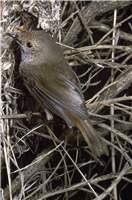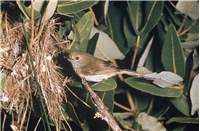Family
Pardalotidae
Genus
Acanthiza
Species
pusilla
Threats/Control Methods - Regional
Noisy Miners (Manorina melanocephala ) as a major threat to Brown Thornbills, as thornbills are absent from areas where the miners are present in dominant numbers. They are also sensitive to the declining health of Canberra's surrounding woodlands, due to land clearing and habitat simplification.
Threats/Control Methods - Local
Within the suburbs, domestic Cats (Felis catus) are likely to attempt to hunt Brown Thornbills.
Local/Urban Actions
Collecting firewood from nature reserves or national parks should not be undertaken, as this will impact on the important foraging resources. Gardeners can encourage the species by ensuring their yard consists of a good mix of trees, shrubs and ground litter. Cat owners can prevent their pets preying on the species by installing a cat run or enclosure.
Common Names
Brown Thornbill, Inland Thornbill, Broad-tailed Thornbill, Red-rumped Thornbill, Whitlocks' Thornbill, Brown Tit, Whitlock's Tit, Tanami Tit, White-scaled Tit, Lake Way Tit, Brown-rumped Tit, Browntail, Scrub Thornbill, Tit-bat
Distinguishing Features
The Brown Thornbill is small plump bird about 10cm in size. It has a cream breast and belly with black streaks across the throat and chest. It has dark red eyes and a reddish brow and rump. Young birds are very similar to the adults, with a paler eye colour.
Survey Techniques
Call and visual identification.
Species Call
A wide range musical whistles and trills, deep notes, harsh scolding and mimicry.
Similar Species
The shape and size is similar to other Thornbills, including the Buff-rumped Thornbill (Acanthiza chrysorrhoa ), however this bird has distinct yellow colouring. Its call has a similar sound to the call of the White-browed Scrubwren (Sericornis frontalis ).
Distribution
The Brown Thornbill is common to the southeast of Australia, including TAS.
Country of Origin
Australia
Conservation (Pet/Pest) Status - Regional
Population numbers have increased by six times since 1981, making it one of the top ten most common birds in the ACT region, breeding in the surrounding woodland reserves (COG).
Conservation (Pet/Pest) Status - National
Secure, not listed under the EPBC Act 1999. The population of King Island, Acanthiza pusilla archibaldi, is considered Critically Endangered, as previous declines almost lead to extinction on the island.
LSCCES Population
The species was found most commonly at CSIRO, BMt and ANBG, while none were sighted at NMA, in Turner or Civic West.
Associated vegetation community
The Brown Thornbill is found in all dense shrubby habitats in the temperate and subtropical zones, including eucalypt forest, woodland, shrubland, heath and rainforest. They are found from the coast up to 1200m. In Canberra, they are common to home gardens, especially those near large patches of remnant vegetation or nature strips with shrubby understorey.
Limiting Resources
The Brown Thornbill requires dense shrub vegetation. It requires an environment free from Foxes (Vulpes vulpes) and Cats (Felis catus), as its nests are low to the ground.
Breeding
The female builds a small, untidy domed nest from grasses and bound with spider web. She incubates three eggs for 19 days and both parents then feed the young for 16days. In the Canberra region the Brown Thornbill has an early breeding season, starting with nest building in July, nest activity until October and dependant young until early November. The Fan-tailed Cuckoo (Cacomantis flabelliformis ) is known to lay an egg in the nest of the thornbill and leave, giving the unknowing thornbills parental care over another species.
Behaviour
The birds are found in pairs or small groups with other insectivores, constantly singing and actively foraging through vegetation or fluttering after insects.
Functional Group
Food Species
The Brown Thornbill feeds mainly on insects, sometimes eating seeds, nectar or fruit.
Predators
Brown Thornbills are one of the most common bird species caught by Cats (Felis catus) in the suburbs.
Interesting Fact
The Brown Thornbill responds to humans by imitating our calls.
References - (reader suitability of references, P=Primary teachers, S=Secondary students, T=Tertiary students and researchers)
Books:Freudenberger, D. 2001. Bush for the birds: Biodiversity enhancement guidelines for the Saltshaker Project, Boorowa, NSW. Consultancy report to Greening Australia ACT and SE NSW Inc. CSIRO Sustainable Ecosystems. Canberra. S, T
Morcombe, M. 2000. Field Guide to Australian Birds. Steve Parish Publishing. Archerfield. Australia P, S, T
Taws, N. et al. 2001. Bringing Birds Back: A Glovebox Guide for Bird Identification and Habitat Restoration in ACT and SE NSW. Greening Australia ACT and SE NSW Inc. P, S, T
Veerman, P. 2003. Canberra Birds: A report on the first 21 years of the garden bird survey. Philip Veerman and Canberra Ornithologists Group. Canberra. S, T
Internet: Birds in Backyards. 2006. [online]. Available at:http://www.birdsinbackyards.net P, S, T
Canberra Ornithological Group (COG). 2004. Birds of Canberra Gardens. COG and the ACT Department of Urban Services. [online]. Available at:http://garden.canberrabirds.org.au/ P, S, T
Online Publications: Garnett, S. and Crowley, M. 2000. The Action Plan for Australian Birds 2000. Department of Environment and Water Resources. [online]. Available at: http://www.deh.gov.au/biodiversity/threatened/publications/action/birds2000/index.html S, T
Nix, H. and Cunningham, R. 2006. Birds of the Lower Sullivans Creek Catchment, Canberra ACT. Prepared for the Life in the Suburbs project using data from the Lower Sullivans Creek Catchment Ecological Survey (LSCCES). Australian National University. Canberra. [online]. Available at: http://www.lifeinthesuburbs.com.au/category.php?id=65 S, T
Olsen, P. et al. 2005. The State of Australia's Birds 2006: Invasive Species. Supplement to Wingspan 16:4. Birds Australia. [online]. Available at: http://www.birdsaustralia.com.au/soab/SOAB2006.pdf S, T


 Top
Top Top
Top